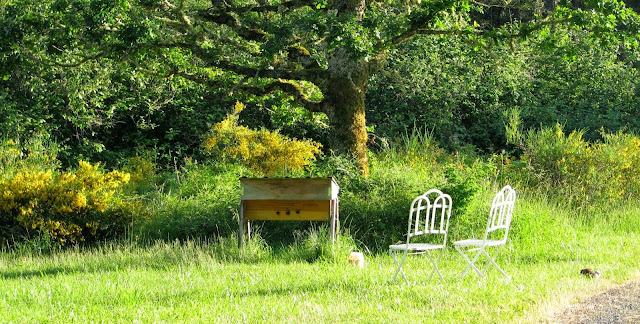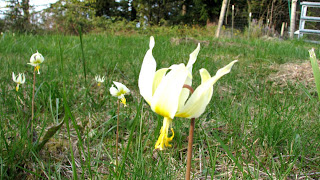Ah, Spring is upon us. The bees are buzzing in and out when the rain stops and the Morel mushrooms will soon be adorning my special white bean soup. We made it through another winter and it feels great!
There are certain flowers on the Homestead that bring me a lot of joy to see peeking above the Dew Berries or weathered grass.
These are what my mom called "Lambs Tongue" but they are also commonly known as
White Fawn Lilly (
Erythronium oregonum). I spend a lot of time in the early summer trying not to mow their beautiful speckled leaves, which the flowers leave behind to gather sun for next years blooms.
Then there is the illusive
Western Trillium (
Trillium ovatum) which takes seven years to bloom from a seed. As children we were never allowed to pick these since the act of picking it, killed it. The bulb cannot recover it's strength without its stem and three leaves.
But my very favorite is the Fairy Slipper.
This
Western Fairy Slipper (
Calypso bulbosa var. occidentalis) is our tiny native orchid. I actually grew up calling it "Lady Slipper" which is what my Mom and Grandma called it. That is why "common names" can be confusing, they tend to be different for the same plant depending on localities and families.
The story of this Fairy Slipper is one of the experiences that helped me overcome my reluctance and brought me back to the Homestead.
I carried this plants' ancestor back to this spot on horseback.
When I was about 10 years old, I rode my horse over to my friends farm a few miles away. It was a rare, warm and sunny April weekend
. When I got to my friends house, she caught her horse and off we went into her back woods. Our Homestead is on a rocky mountain top with a few winter springs here and there but the land is fairly arid. Her families property was at the bottom of the mountain and had a much more verdant ecosystem, with strings of ponds and lakes in deep woods.
We loved to ride our horses down to the lakes and let them graze while we hopped from one floating log to another trying to cast our fishing line directly in front of the "lunkers" we could see in the lakes, sunbeams piercing the water.
In retrospect I think we didn't really want to catch the fish on these trips. Catching a fish meant hurrying home. And we wanted to do anything but hurry home.
Anyway, these trips into the forest usually degraded into chasing one of our horses who was tired of waiting around or it turned into a deep woods snoop to find her teenage brothers secret fort.
This day it was the latter. And as we followed rabbit trails through the underbrush looking for tell-tale boot prints or a flash of dropped paper or cloth in the deep green moss floor of the woods I spied a Fairy Slipper in bloom. Recalling my mothers exclamations of joy anytime she spied one of these delicate creatures in the woods, I decided I would bring it to her. I dug it up carefully from the duff with my fingers and set it into a scrap of wax paper. I nestled it under the pommel of my saddle and there it rode for the rest of the days adventures.
When at dusk I rode up our driveway and dismounted, I excitedly pulled the Lady Slipper from my saddle and brought it to my mother.
Her reaction was the opposite of what I had imagined on my long ride home. Being an avid botanist and gardener, she gasped in sadness and chastised me for digging up the delicate orchid. It would surely die now.
Crestfallen I apologized, handed her the plant and went to bed. Of course she was right. Fairy Slippers were rare and that was because they only grew in very specialized niches in the ecosystem.
The next morning my Mom apologized and thanked me for my thoughtfulness. But I had thought about the plant all night and I wanted to set things right. I couldn't return it, since I would never find the spot I dug it up in again.
I asked if I could plant it outside. She smiled and nodded but also expressed her doubt that it would survive.
I wandered around the Homestead clutching the plant. I sought out the damp shady places I knew of, but nothing seemed to be like the place I had found it, until I found the mossy stump. It seemed right to me, but it was only a guess and a hope.
It turns out it was a suitable spot. And to this day, around the first of April there is a 20 foot puddle of these Lady Slipper orchids around the spot where the mossy stump used to be. I had inadvertently established a new colony of the tiny orchids.
And here they are decades later! How such small happenings can effect our lives is difficult to predict but this one event helped shape who I am and what I care about, and what I do to this day.
This tiny treasure helped to bring me back to the land I love. That's a lot like a Fairy Tale if you ask me.











































